
The CSU Dominguez Hills University Housing Mural Project is an art installation wrapping the exterior walls of the University’s new 500-bed student residence hall on campus. The complex was designed to feature large-scale murals in eight locations. Using a digital mural wrap reproduction process, the University has collaborated with Los Angeles artist iris yirei hu, to create a series of artworks for the designated spaces.
One of the objectives of the University Housing Mural Project is to celebrate the creative work, history and narratives in the local community. According to the artist, the mural project entitled Survival Guide “fosters an environment for students who are learning to learn, exploring themselves and their peers, struggling and transforming, and experiencing joy.”
iris sees her art as a cultural service. She hopes her murals serve as a backdrop for students living through new experiences and forming relationships. Students will initially struggle in this new environment where they will learn, grow, and transform. iris’ work holds the exploration of oneself to help heal from grief and struggles, to strengthen values informed by both family and community.
The new student residence hall is located on the northeast section of campus. The murals were created through a process involving high-resolution imaging. hu’s artwork was photographed and printed at a large scale on adhesive vinyl. The vinyl is capable of withstanding various elements and climates, allowing the murals to retain their integrity for years to come.
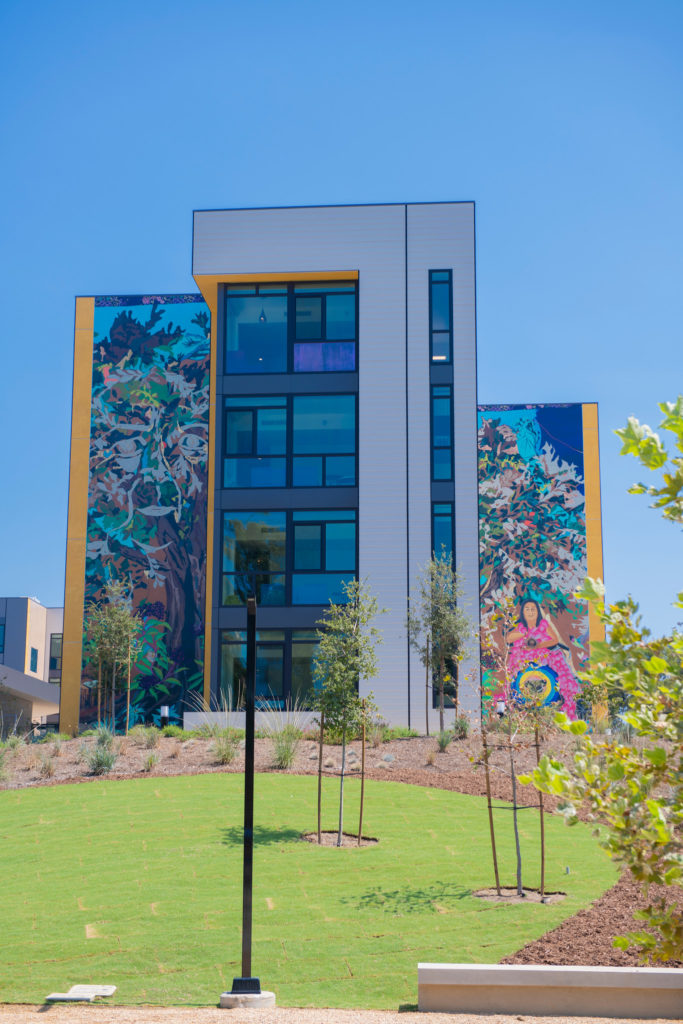
Lessons from Wise Woman (Tongva Elder Julia Bogany), Grandmother Oak Tree, and Hands, 2018.
iris grew up near the San Gabriel Mission, a site of horror, enslavement, and grief for the indigenous people of Southern California. As a child of immigrants, iris has worked with Tongva elder Julia Bogany to deepen indigenous and immigrant relationships.
eternal kiss of two brothers, 2020.
Two blue hands embroider a doily using Croatian hvar and pag lacemaking techniques while the flora in the background refer to three native plants of Croatia: mulberry, iris, and lavender. The work focuses on the intersection of fiber history and landscapes that stretches across cultures and time.
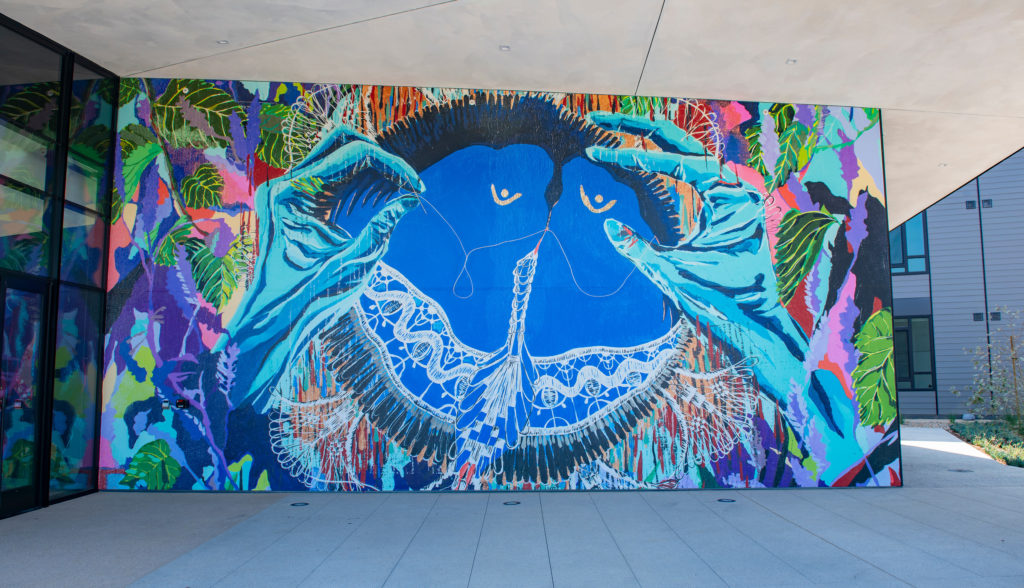

(Above, left of entryway) Magical Thinking, Seeing, and Being: Jimmie Durham, Kendrick Lamar, emi kuriyama, and the Queen of Cups, 2016.
emi and her neighbor Kendrick sit with the indigenous artist and activist Jimmie Durham and are anchored by a symbolic figure from the Tarot. Curious to imagine the conversations that would unfold if the four figures, who would never be in the same room, sat in a blue lunar birth canal, iris wonders how rendering the impossible can give way to possibilities of human, mythic, and inter-spatial coexistence?
(Above, right of entryway) when the Sun devours the Moon, 2017.
The centerpiece of Survival Guide: when the Sun devours the Moon, imagines a mother and her child guided by a grandmother’s spirit sitting on horseback watching the sun absorbing the moon. Amidst global warming and environmental loss, two generations of women find themselves upon a journey of survival.

(Above, left of entryway) La Ofrenda en la casa de Juana, Antonio y Porfirio, 2018
This tapestry reproduction, installed on an interior wall of the residence’s commons building, depicts iris learning weaving and natural dying with Porfirio Gutierrez y familia in Oaxaca, Mexico. Intercultural learning brought the artist closer to the changing environment and to reconsider human relationships with plants, insects, and wildlife. The way to survive is to actively engage in learning, collaboration, and resistance with one another.
(Above, right of entryway) Our intrafemale universe (Nash Glynn), 2017.
This painting depicts iris and her friend, Nash Glynn, in her apartment. Nash’s queer and trans identity opened up possibilities to reimagine practices and performances of womanhood and livelihood in the wake of multiple crises. Learning from one another’s differences helps build relationships, and with relationships, build community.
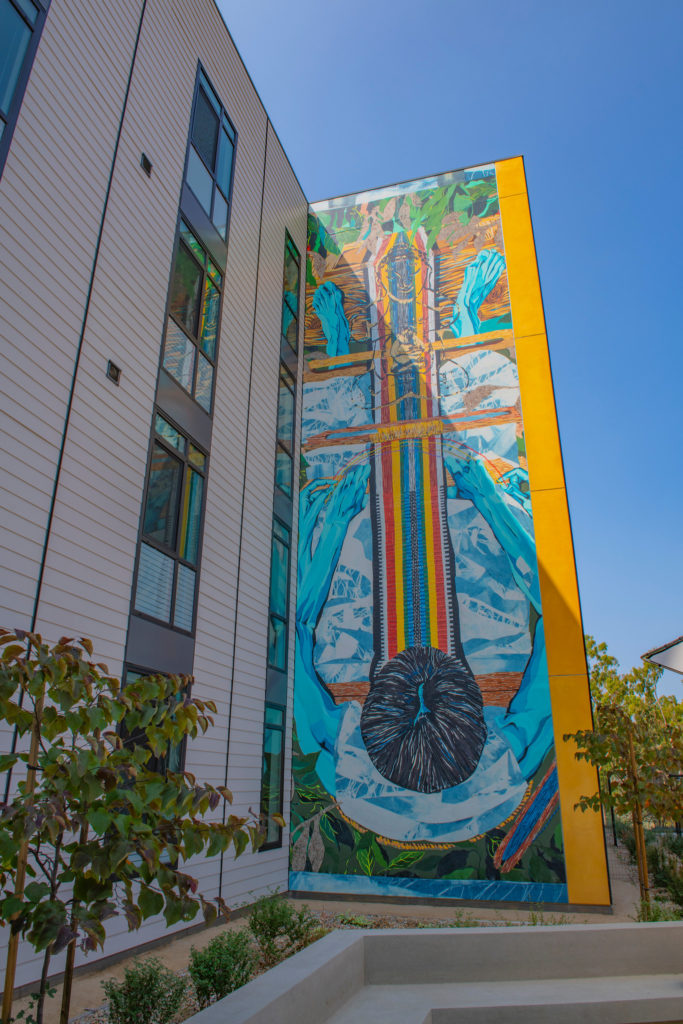
weaver girl limns two rainbows, 2019.
The mural depicts a weaver weaving on the Taiwanese Atayal foot loom, which iris learned how to use from an Atayal master weaver in Taiwan.
The Poem (after emi kuiyama), 2018.
Written by the artist’s late best friend, emi kuriyama, iris yirei hu created this stitched embroidery of her poem and included a sashiko-stitched handkerchief that was given to her by emi as a gift. Having emi’s image and work serves as a kind of creative and spiritual homecoming for iris.
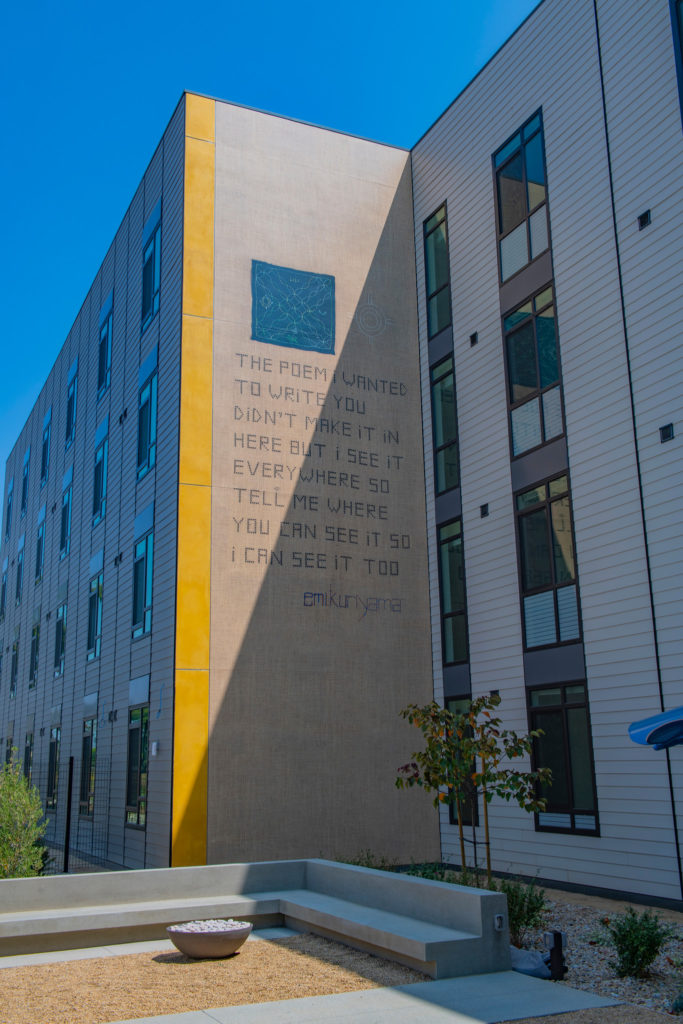
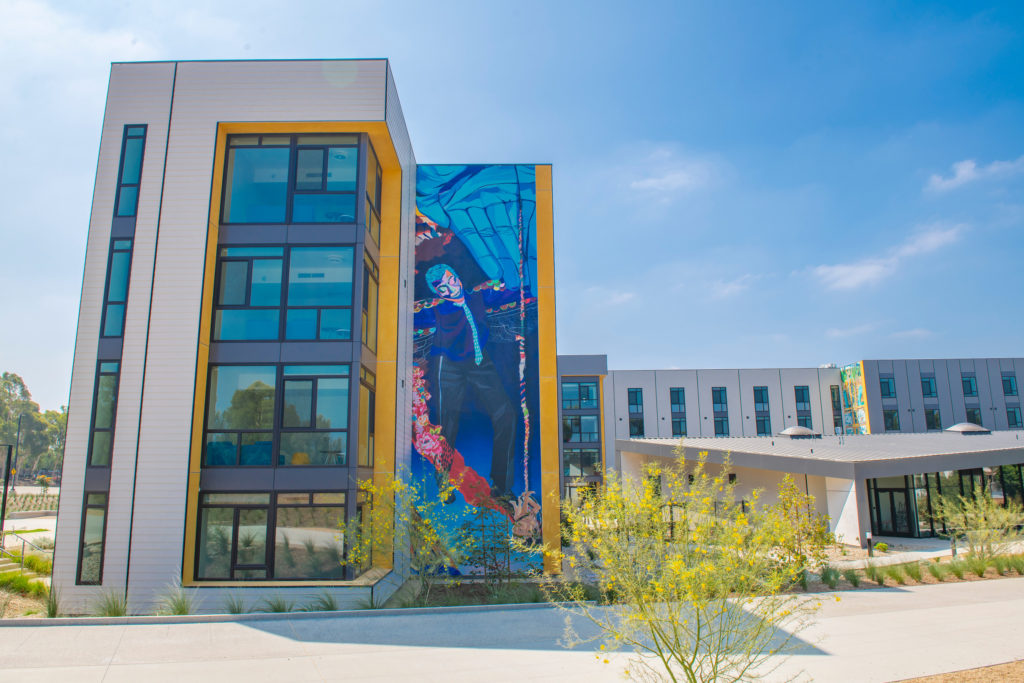
i eat your body and drink your blood, 2017.
James Baldwin descends into space as a dragonfly. This scene depicted in this mural is part of a larger work titled Survival Guide: joy meant to envision grief, struggle and study in an effort to collectively transform.
They wove what they say (day), 2019.
First half of a diptych in collaboration with artist Paula Wilson, iris and she cultivated a spiritual and bodily relationship with the native yucca plant and fused them together into tapestries using the pressed pedals, woodblock printing, cyanotypes, handmade paper out of yucca stalks, and acrylic.
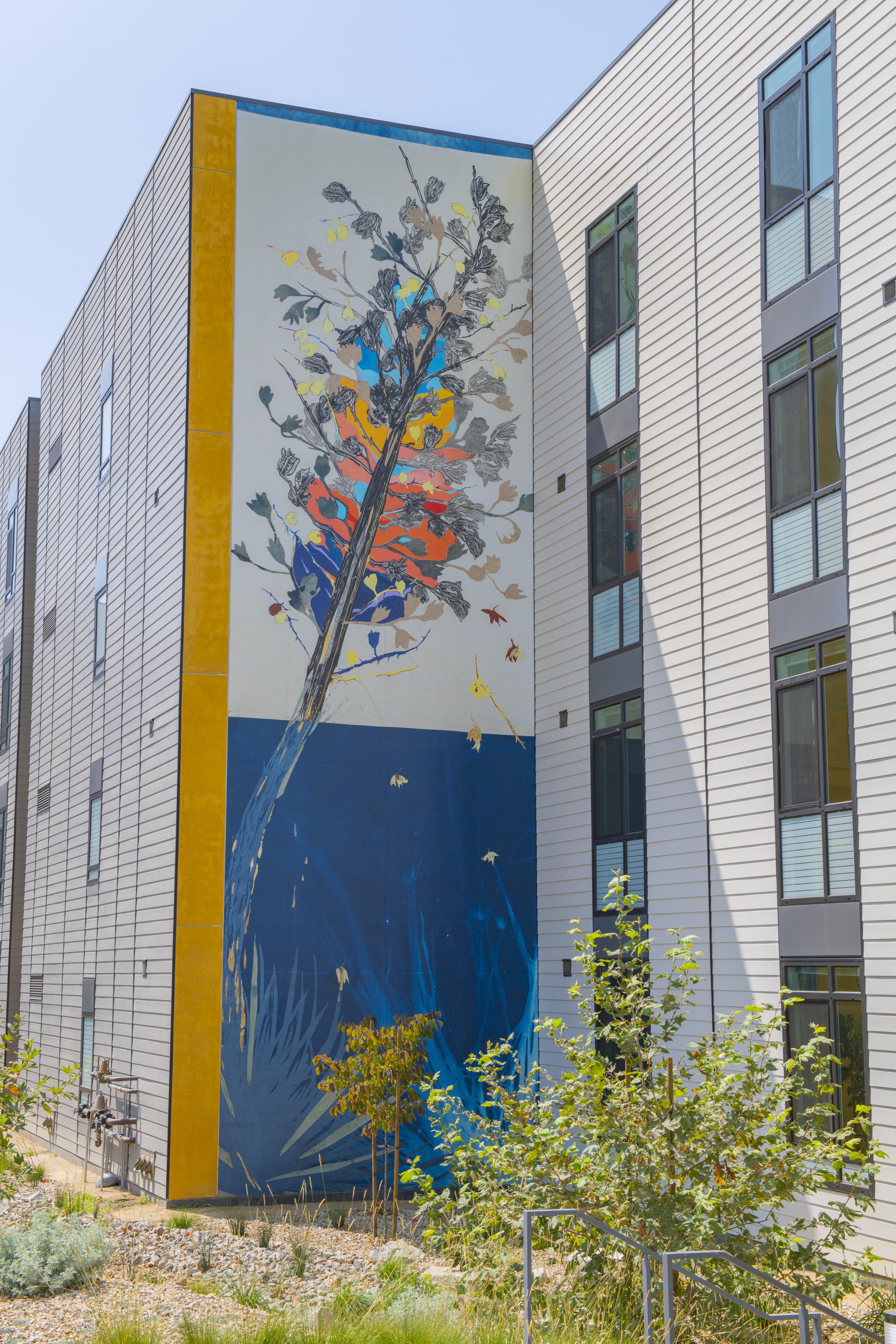
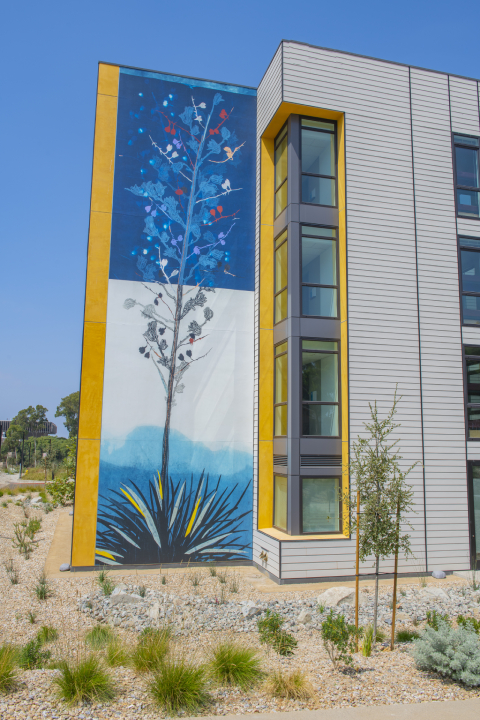
They wove what they say (night), 2019.
Second half of a diptych in collaboration with artist Paula Wilson, iris and she cultivated a spiritual and bodily relationship with the native yucca plant and fused them together into tapestries using the pressed pedals, woodblock printing, cyanotypes, handmade paper out of yucca stalks, and acrylic.
About the Artist
iris yirei hu is a Los Angeles based artist who works in painting, fibers, text, and installation. She is interested in how people, places, and things are related, and sees weaving and craft practices as a manifestation of entangled interdependencies. In a single assemblage, one may encounter materials, stories, living organisms, and ecologies from Taiwan, California, Southern China, Mexico, and the American Southwest. Her work centers on learning as a method of engagement, and is both research based and dependent on lived experience. This research leads her to form connections and collaborate with artists, scientists, historians, keepers of tradition, and community stakeholders and organizers.


